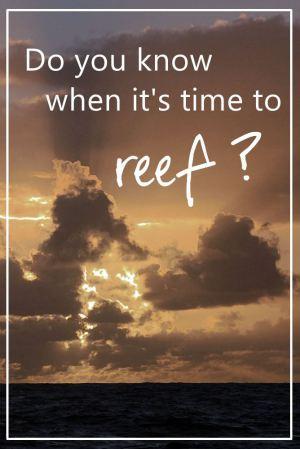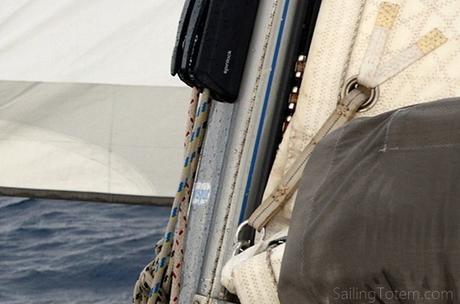

When do you reef? How should you reef? What are some excellent ways to screw it up? A few thoughts from Jamie (filtered through fun with salty sayings and his fondness for puns).

After a few pints, the sailor, three sheets to the wind recounts his battle at sea: the wind hit hard and fast, time to batten down the hatches and give a wide berth to sailors that don’t know the ropes or suffer mal-de-mer. You’ve got to pull hand over fist to the bitter end or go by the board. Reef early, ho hum.
When between the devil and the deep blue sea it may be necessary to reduce sail area, but what does reef early even mean: Before the first cup of coffee? Today, because it’ll be windy tomorrow? Almost certainly it’s sage advice for safety. “You’ll find yourself your beam ends or full to the gunnels if you don’t reef early.” But what if you cannot?
Twist over heel
On occasion, reefing early is inconvenient or a moment passed lost in a surprise wind increase or too much work. Don’t walk the plank, learn to depower by setting the mainsail with twist to reduce heel. In practical terms, too much wind equates to too much power. Monohulls respond by heeling, a lot. The scale of forces acting on sails, rigging, and skipper’s docile state go up considerably. Multihulls don’t heel, of course, thus escalating rigging forces even more than monohulls.

Being overpowered also causes an imbalance in driving force generated by sails. This tends to cause a boat to round-up (turn) to windward. Since a boat is all soul and no brain, it doesn’t make good navigational choices while rounding-up. In this moment it’s prudent to counteract rounding-up with proper application of apposing rudder forces. Directing rudder to steer to leeward will maintain a controlled, straight course. This is called weather helm, referring to a tiller pulled to windward. Weather helm slows boat speed and stresses the steering system because the rudder acts like a brake turned sideways to the flow of water.
Sailing along the coast of Tahiti, we had 35 knot gusts rolling down the mountainous island, punctuating an otherwise pleasant 20 knot breeze. With each gust, a nearby cruiser tried to depower by easing the genoa sheet. This exacerbated the imbalance in driving forces, causing them to round-up into an uncontrolled tack and point directly towards a nearby reef. To depower correctly and quickly:
- ease the mainsheet
- set the mainsheet traveler the leeward
- uncleat the vang (if you don’t have one, you should)
If you shake a leg at these steps the upper section of mainsail will twist to leeward. Wind slips by the mainsail with less force on sails, rigging, and rudder. It’s fine if the main luffs some, but best that it doesn’t flog. Additionally, you can tighten the outhaul and backstay if adjustable and now safely ease the genoa/jib sheet without risk of uncontrolled tack. Remember twist over heel when reef early didn’t happen.
Tuck by twenty, leaves you plenty
The sensation of how sailboats respond to increasing wind varies widely. Some accelerate. Some don’t, but heel way over. Multihulls don’t heel and may or may not accelerate, so it can be harder to sense wind changes. Wind direction relative to the boat also matters. Going upwind enhances this feeling, while downwind softens it.
Consequently, knowing when to reef is sometimes obvious, but often not. It takes time on water to develop a natural feeling. Even then, fickle winds can surprise. What’s certain is pushing a boat hard, not depowering or reefing is reckless. The sailors on the boat that tacked out of control in Tahiti, boasted about the great conditions and how fast they went by not reefing when others did. Having watched them on the water, I was taken aback. If there is ever doubt about when to reef, do so by 20 knots of wind. By and large, reefing is easier and safer in less wind; and the boat will often go faster, point better, and with less stress than the unreefed sailor, chock-a-block with false pride.
Knowing when to reef is an hors-d’oeuvre. Knowing how to reef well is five course meal. How depends many variables: reef at the mast or from cockpit, using single or multi-part reefing systems, with lazy jacks or not, slab reefing or furling, etc. Here are a few tips that may help for the most common reefing systems.
Reef at any wind angle
Pointing a boat into the wind in order to reef is a dramatic course alteration that is unnecessary, adds complexity, and increases risk. Instead maintain course and depower the mainsail. Then, as you lower the halyard to reef, also keep tension on the leech reef line. This keeps the sail flatter so it doesn’t get plastered against rigging, bunching up and causing friction. If going dead downwind a small course adjustment of 15 to 20 degrees lowers the risk of accidental gybe and reduces the friction issue (especially if the mast has swept back spreaders).

Dog ears
If the luff reef is secured on a reef hook, doing so with use dog ears (or dog bones) is easier than using the reef ring itself. Dog ears are two round rings webbed together through the luff reef ring. Only one round ring needs to be secured on the hook, and it shouldn’t be a struggle. If it is, the dog ears may be too short. Make the webbing strop between round rings long enough to easily secure – 6 to 12 inches is common.
Low friction rings
The leech reef line forms an acute angle passing through the leech reef ring in the sail. Consequently, the reefed portion of sails gets scrunched by the unreefed portion of sail and reef line, which can make reefing harder and cause sail chafe. The solution is low friction rings lashed to the leech reef ring. Use 3mm Dyneema line for the lashing, with 6 inches of separation between reef ring and low friction ring. Now the leech reef line passes through the low friction ring giving enough separation so the reefed section of sail isn’t so scrunched. The low friction ring is smoother and has a wider turning radius then the reef ring, making reefing a little easier with less chance for chafe.

Anchoring the leech reef line
Booms often have a pad eye to secure the bitter end of leech reef line. It’s better to anchor the leech reef line around the boom. This is far stronger than an external fitting that can weaken from corrosion. The reefing line can pass through the eye when going around the boom to hold its location, but that isn’t required.
Get the squeak out
If reefing line is not high modulus, such as Spectra/Dyneema, it can stretch and squeak loudly against the boom. To quiet this, use a high modulus strop around the boom and attach reefing line to this strop. No stretch, no squeak.
Reefing shouldn’t be a call to panic stations. Learn to depower (twist over heel) and reef early (a tuck by 20 leaves you plenty) for in control, plain sailing.
More on our amazing current destination, St. Helena, in the next post! For more wisdom from Jamie’s sailmaker/rigger thoughts, see Sailmaker SAYS! and all posts tagged /sailmaker.

